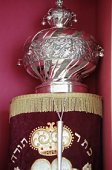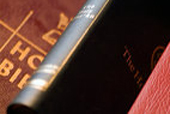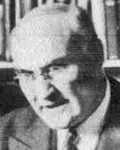|
*
AN
ANALYSIS OF FIGURES OF SPEECH
Message 4:
THE METAPHOR
*
|
"The metaphor is
one of the very common figures found throughout the
Scriptures."
|
THE METAPHOR
THE
METAPHOR is one of the very common figures found throughout the
Scriptures. Like the simile it is a simple comparison. The
simile compares two objects, persons, or things and usually
employs the word as, or like. An illustration of
the simile is, He fought like a lion. I can make the same
comparison, but change the manner of statement. Taking the
person concerning whom I am speaking out of the class of human
beings and putting him into the class of animals, I can say, "He
was a lion in the fight." In using either of these figures, I am
selecting that outstanding characteristic of the lion and of his
fighting to emphasize the pugilistic tendencies and actions of
the man concerning whom I am speaking.
Many of the figures of the metaphor type, as well as of the
simile, are drawn from the animal kingdom. This is especially
true in the early part of the Scriptures. For instance, Jacob,
in blessing his sons, speaks of Judah in these words:
Judah is a lion's whelp.
Here Judah and his descendants are thought of as young lions.
Jacob takes them out of the class of human beings and thinks of
them as if they were a lion. Continuing the same idea he
declares, From the prey, my son, thou
art gone up (Gen. 49:9). Judah is thought of as a
lion that has seized upon his prey and killed it. After having
eaten what he chooses, he goes up to his lair in some mountain
fastness where he is absolutely free from all attack, of any
sort. In the same chapter Jacob thinks of his various sons in
terms of different animals. For instance in 49:14 he speaks of
Issachar's being a strong ass, Couching
down between the sheepfolds. In verse 17 he thinks of
the tribe of Dan and those descending from him as
a serpent in the way, An adder in the
path. That biteth the horse's heels, So that his rider falleth
backward. Then again, in verse 21, he speaks of
Napthtali as a hind let loose.
Joseph is then thought of as being a
fruitful bough, A fruitful bough by a fountain; His branches run
over the wall (vs. 22). In speaking of Joseph, he
thinks of him as a grapevine that is flourishing and very
fruitful. In speaking of Benjamin and his tribe he declares that
he is a wolf that raveneth: In the
morning he shall devour the pray, And at even he shall divide
the spoil (vs. 27). It is clear from all these
references that, with the exception of Joseph, Jacob draws all
of his metaphors from the animal kingdom.
In Deuteronomy 32:34 Moses thinks of God as a mighty warrior who
has His sword and His arrows, and who goes into battle against
the enemies of Israel, conquering them and treading them under
His feet. Thus he thinks of the power of God by which He will
destroy both His own enemies and those of Israel as a sharp,
glittering sword. Thus infinite power is thought of in the
category of a literal sword with which Jehovah, the war hero,
fights against His enemies and slays them. (See especially verse
14). In verse 42 he thinks of the arrows in this manner:
I will make mine arrows drunk with
blood,
And my sword shall devour flesh.
Still in thinking of Jehovah as a warrior with His sword and
with His arrows, Moses mixes his figures (a practice that is not
sanctioned by modem English, but perfectly proper in the genius
of the Hebrew tongue and spirit), and speaks of the arrows as if
they were actual people who had drunk of blood of their victims.
The same figure appears in Isaiah 34:5:
For my sword hath drunk its fill in heaven: behold, it shall
come down upon Edom, and upon the people of my curse, to
judgment.
Frequently the place where people are located by the Lord is
thought of as the nest of a fowl. For instance, in Numbers 24:21
we read of the Kenites:
Strong is thy dwelling-place,
And thy nest is set in the rock.
Here the mountain fastness where the Kenites dwelt is thought of
as probably an eagle's nest which is put high up in the
mountains far from access by men or beasts. A similar figure is
used by Jeremiah concerning Edom: As
for thy terribleness, the pride of thy heart hath deceived thee,
0 thou that dwellest in the clefts of the rock, that holdest the
height of the hill: though thou shouldest make thy nest as high
as the eagle, I will bring thee down from thence, saith Jehovah
(Jer. 49:16). Some of the territory of the Edomites was very
mountainous and rocky. For instance, the city of Petra - "the
rose-red city half as old as time" -
was one of their fortresses, or strongholds. This city
was practically impregnable in the ancient days. Jeremiah
compared it to the eagle's nest and thought of it as being in
the high mountains, inaccessible to all of their enemies. Again,
Obadiah, who spoke an oracle against Edom used the same figure
in the following statement: Though thou
mount on high as the eagle, and though thy nest be set among the
stars, I will bring thee down from thence, saith Jehovah
(Obadiah, vs. 4). Habakkuk used the same figure in referring to
Babylon, in which expression there evidently is an allusion to
the hanging gardens of Babylon: Woe to
him that getteth an evil gain for his house, that he may set his
nest on high, that he may be delivered from the hand of evil!
(Hab. 2:9)
Jeremiah noted the folly of Israel in her apostatizing from God
and in her adoption of idols as objects of warship:
For my people have committed two evils:
they have forsaken me, the fountain of living waters, and hewed
them out cisterns, broken cisterns, that can hold no water
(2:13). A fountain of living, running water is of course far
better and superior to that of the rain-water that runs into a
cistern that is hewn out in the rocks. Such a cistern frequently
was broken and the water was spilled. It therefore ceased to be
of any benefit or profit to the men who thus constructed it. God
is, therefore, in this passage thought of as being a fountain of
living, running water - that never runs dry. But the idols and
idol-worship are thought of as broken cisterns that cannot hold
water to meet the needs of the worshiper.
Frequently the prophets spoke of certain spiritual matters in
terms of the Jewish ritualism. As an example of this usage, note
the following:
I will wash my hands in innocency:
So will I compass thine altar, 0 Jehovah.
Doubtless this language is based upon the Mosaic regulation that
the priests before entering into the tent of meeting should
bathe themselves with water, lest they die, when they would come
near to the altar to minister and to burn an offering made by
fire unto Jehovah (Ex. 30:20). The great laver was located
between the altar of burnt offerings and the sanctuary. After
the priests had made the proper sacrifices, they passed by the
laver at which they bathed and cleansed themselves ceremonially
and then entered the holy place. Paul was thinking in terms of
such an act of approaching God in the following statement:
But when the kindness of God our
Saviour, and his love toward man appeared, 5 not by works done
in righteousness, which we did ourselves, but according to his
mercy he saved us, through the washing of regeneration, and
renewing of the Holy Spirit; 6 which he poured out upon us
richly through Jesus Christ our Saviour (Titus
3:4-6). In Psalm 51:7 David prays,
Purify me with hyssop, and I shall be
clean:
Wash me, and I shall be whiter than snow.
This language is based upon and borrowed from such passages as
Leviticus 14:6,7,51. In these verses Moses was speaking about
the ceremonial cleansing of the leper who was pronounced clean
by the priest, upon a thorough examination of his case, who
noted the fact that there had disappeared from the person
afflicted every sign and symptom of that dread disease. It is
also possible that David's language might be an echo of the
ceremonial cleansing of one who had become unclean, according to
the law, and who was cleansed ceremonially by the water of
purification mentioned in Numbers 19:18,19.
In I Corinthians 5:7,8, Paul speaks of Christ as being our
passover, who had been slain for us. We are therefore to purge
out the old leaven of wickedness and malice and are to observe
the passover in the newness of the spirit and power of the life
imparted to us by the Spirit of God. This language of course is
based upon and borrowed from Exodus, chapters 12 and 13. An
understanding of the ancient ritualism of the passover makes
intelligible Paul's language. Our Lord in the Sermon on the
Mount (Matt. 5:13) spoke of His disciples as being the salt of
the earth. Salt is a preserving power, especially of meats; and
of other things. Again, in verse 14, He compared the Christians
to light. We are to the world what physical literal light is to
the darkness.
There are literally hundreds upon hundreds of metaphors
throughout the Scriptures, but these are sufficient to call
attention to the general principles of understanding and
interpretating such figurative language.
*
*
Return to Home Page

|


